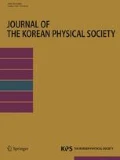Abstract
Complex networks are ubiquitous in real-world systems. In the last decade, the investigation of complex networks has received much attention. Most of this research suggests that the topological properties of networks have an important influence on the evolution of cooperation. In this paper, we used the prisoner’s dilemma game and snowdrift game as models to study the problem of cooperation evolution on heterogeneous random networks. We found that the heterogeneity of the networks plays a more important role in promoting cooperation than the average clustering coefficient and average path length of the networks do. The higher the heterogeneity of the networks is, the more conducive the emergence and spread of cooperation is. In addition, we found that increasing the average degree of networks would be detrimental for cooperation to thrive.
Similar content being viewed by others
References
M. E. J. Newman, Siam Rev. 45, 167 (2003).
R. M. May, Trends Ecol. Evol. 21, 394 (2006).
M. Perc and A. Szolnoki, BioSystems 99, 109 (2010).
R. Albert and A-L. Barabási, Rev. Mod. Phys. 74, 47 (2002).
L. A. N. Amaral, A. Scala, M. Barthélémy and H. E. Stanley, Proc. Natl. Acad. Sci USA 97, 11149 (2000).
Y. Kim, W. Choi and S. H. Yook, J. Korean Phys. Soc. 60, 621 (2012).
S. N. Dorogotsev and J. F. F. Mendes, Evolution of Networks: From Biological Nets to the Internet and WWW (Oxford University, Oxford, 2003).
F. L. Pinheiro, F. C. Santos and J. M. Pacheco, Phys. Rev. Lett. 116, 128702 (2016).
F. C. Santos, J. M. Pacheco and T. Lenaerts, PLoS Comput. Biol. 2, e140 (2006).
M. Nowak and K. Sigmund, Nature 437, 1291 (2005).
D. J. Watts and S. H. Strogatz, Nature (London) 393, 440 (1998).
M. E. J. Newman, Phys. Rev. E 64, 025102R (2001).
F. C. Santos, J. F. Rodrigues and J. M. Pacheco, Phys. Rev. E 72, 056128 (2005).
F. C. Santos, J. M. Pacheco and T. Lenaerts, Proc. Natl. Acad. Sci. USA 103, 3490 (2006).
H. Ohtsuki, C. Hauert, E. Lieberman and M. A. Nowak, Nature 441, 502 (2006).
H. Ohtsuki, Y. Iwasa and M. A. Nowak, Nature 457, 79 (2009).
R. Axelrod and W. D. Hamilton, Science 211, 1390 (1981).
C. Hauert and M. Doebeli, Nature 428, 643 (2004).
H. Qi, S. Ma, N. Jian and G. Wang, J. Theor. Biol. 368, 1 (2015).
G. Szabó and C. Töke, Phys. Rev. E 58, 69 (1998).
A. Traulsen, M. Nowak and J. Pacheco, Phys. Rev. E 74, 011909 (2006).
T. Sasaki, Å. Brännström, U. Dieckmann and K. Sigmund, Proc. Natl. Acad. Sci. USA 109, 1165 (2012).
J. M. Smith and G. R. Price, Nature 246, 15 (1973).
F. C. Santos and J. M. Pacheco, J. Evol. Biol. 19, 726 (2006).
F. C. Santos, J. F. Rodrigues and J. M. Pacheco, Proc. R. Soc. B 273, 51 (2006).
Z-J. Xu, Y. Le and L-Z. Zhang, Phys. Rev. E 89, 042142 (2014).
F. L. Pinheiro, M. D. Santos, F. C. Santos and J. M. Pacheco, Phys. Rev. Lett. 112, 098702 (2014).
S. Lee, J Korean Phys. Soc. 67, 1703 (2015).
Acknowledgments
This work was partly supported by the National Natural Science Foundation of China under Grant No. 4187 4113, the National Natural Science Foundation of China under Grant No. 11604243, the Natural Science Foundation of Tianjin, Project No. 16JCQNJC01600, and the Scientific Research Project of Tianjin Municipal Education Commission under Grant No. 2017KJ239.
Author information
Authors and Affiliations
Corresponding authors
Rights and permissions
About this article
Cite this article
Li, R., Xu, Z. & Zhang, L. Heterogeneity of Networks Promotes Cooperation in the Prisoner’s Dilemma and the Snowdrift Game. J. Korean Phys. Soc. 74, 831–837 (2019). https://doi.org/10.3938/jkps.74.831
Received:
Revised:
Published:
Issue Date:
DOI: https://doi.org/10.3938/jkps.74.831




